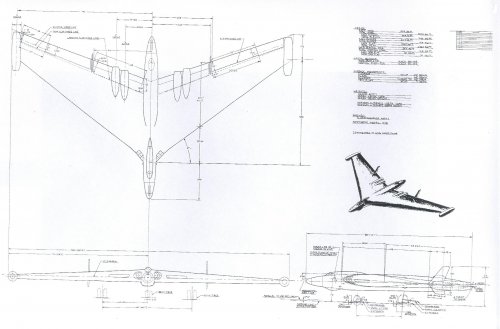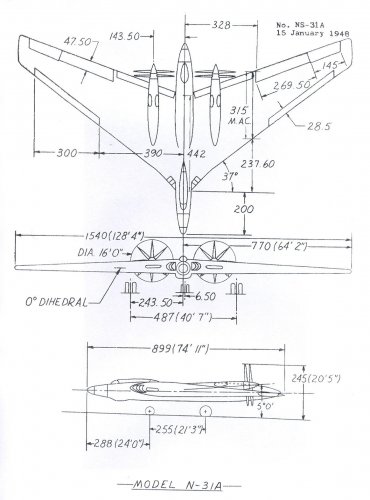While visiting the Western Museum of Flight in Torrance, I had finished discussing with the museum staff my previous blog posts on advanced 1950s Northrop flying wing bomber designs and Northrop cargo transport projects, as well as the recent maiden launch of the Boeing CST-100 Starliner last year, and eventually I was touring the museum's main building when a trio of desktop models of planes developed in Southern California caught my eye while touring the museum's displays. Although the glass case displays at the museum contain notable Northrop products like the YF-23 Black Widow II/Grey Ghost prototype stealth fighter that lost to the F-22 Raptor as well as the Northrop YF-17 Cobra prototype lightweight fighter and 1940s flying wings, but also desktop models of the North American X-15 and Douglas C-124 Globemaster II heavy airlifter, the three desktop models I came across had never been displayed in a glass case before during my previous visits of the Western Museum of Flight.
The first of the three desktop models that caught my eye while visiting the Western Museum of Flight worth discussing is a 1/40 scale desktop model of the North American F-107 prototype fighter-bomber donated by Donald Spaulding. While gazing at a glass case containing memorabilia and artifacts concerning the history of aviation development in Southern California, I happened to notice an F-107 desktop model inside a glass case containing photos of the U-2 Dragon Lady and SR-71 Blackbird spyplanes but also a copy of a memoir by Ben Rich (1925-1995) detailing his years as head of the Lockheed Skunk Works from 1975-1991. The F-107 is a plane that most military aviation gurus don't think about too much, but it was one of the most advanced US combat planes built by North American Aviation apart from the B-70 Valkyrie trisonic heavy bomber. North American Aviation made its mark on US military aviation history with the WW2-era P-51 Mustang that escorted vast armadas of B-17 and B-24 bombers over Nazi-occupied Europe, the F-86 Sabre swept-wing jet fighter of Korean War fame, and the first US supersonic jet fighter, the F-100 Super Sabre. The F-107 began life as an advanced variant of the F-100, the F-100B (company designation NA-212) in response to a USAF requirement for supersonic fighter-bomber to replace the F-84F Thunderstreak. Although supersonic like the F-100, the F-100B differed in having an engine intake atop the fuselage and pointed nose for housing the interception radar, leading the USAF to redesignate the F-100B as the F-107. Three prototypes were built, the first one taking to the skies on September 10, 1956. The F-107 performed well in flight tests, but the USAF selected the Republic F-105 Thunderchief over the F-107 as the next American fighter-bomber in 1957. Fortunately, two of the three F-107 prototypes survived the breaker's torch and are now in museums in the US, with 55-5118 displayed at the Pima Air & Space Museum in Arizona, and 55-5119 on display at the National USAF Museum near Wright-Patterson Air Force Base in Dayton, Ohio. North American pitched a carrier-based derivative of the F-107 to the US Navy in 1955, unofficially dubbed "FJ-5" and "Improved FJ-4" by the company, but this proposal did not materialize.
 |
Top: Northrop X-21 desktop model at Western Museum of Flight.
Bottom: Northrop X-21 serial number 55-0408 in flight over the Mojave Desert.
|
Another desktop model of a plane built in southern California that was worth getting my attention at the Western Museum of flight is of the Northrop X-21 experimental aircraft. The X-21 was basically a technology demonstrator for a large transport aircraft equipped featuring long-span wings with laminar flow control surfaces, being based on the airframe of the Douglas WB-66D Destroyer. Northrop believed that a large aircraft sporting a wing with laminar flow control properties could have better fuel efficiency, greater range, and higher endurance, pointing out that an 80 percent laminar wing might reduce overall drag by 25 percent. Therefore, two WB-66Ds (serial numbers 55-0408 and 55-0410) were modified by Northrop to feature a new wing with laminar flow control systems spanning 93 feet 6 inches (28.51 meters) and the underwing Allison J71 turbojets removed and replaced by two General Electric J79 turbojets mounted on the sides of the rear fuselage underneath the horizontal stabilizer, thus being designated X-21. The first flight of the X-21 took place on April 18, 1963, but experience from flight testing suggested that the laminar flow control system were prone to damage from ice, rain, dirt, and dust. Consequently, the US Air Force and NASA decided that application of the laminar flow wing to civil and military transport aircraft was impractical. Both X-21s survive in a derelict state at Edwards Air Force Base, but neither has been restored for display at air museums in southern California.
 |
Desktop model of the McDonnell Douglas MD-91 propfan airliner project
|
The third and final desktop model worthy of discussion that caught my eye while I was at the Western Museum of Flight is of the McDonnell Douglas MD-91, a proposed propfan airliner design of the 1980s. Given the high price of oil in the 1980s, the McDonnell Douglas company, capitalizing on the MD-80 twin-jet airliner, envisaged derivatives of the MD-80 series with two propfan engines (either General Electric GE36 or Pratt & Whitney/Allison 578) under the designations MD-91 and MD-92. Propfan technology (turbofans with swept-blade propellers) was seen by the aeronautical community as offering the benefits of both turbofans and turboprops, combining the fuel economy of turboprop engines with the speed and performance of turbofans in order to offer better fuel economy than turbofan engines. The MD-91 design was to seat 110-120 passengers, while the 157 foot long MD-92 would have seated 165 passengers. An all-new McDonnell Douglas propfan-powered airliner, the MD-94, was similar in size to the MD-92 and could seat 160-180 passengers. Entry into airline service for the MD-91, MD-92, and MD-94 was planned for 1991, 1992, and 1994 respectively. There was also a project for a maritime patrol version of the MD-91 (informally called "P-9D") as a successor to the Lockheed P-3 Orion, but that proposal lost out to the Lockheed P-7 Orion II for the P-3 replacement contract, even though the P-7 would later be cancelled in July 1990 due to cost overruns. McDonnell Douglas modified a number of MD-80s as testbeds for the propfan engines planned for the MD-91, MD-92, and MD-94, and tests were conducted in 1988. Tests with the General Electric GE36 and Pratt & Whitney/Allison 578 seemed to validate the suggested benefits of propfans, but falling oil prices in 1989 caused the airline industry to lose interest in propfan airliners, leading to the axing of the MD-91, MD-92, and MD-94 projects. For these same reasons, another US propfan airliner project, the Boeing 7J7 (J standing for Japan) was cancelled without reaching the hardware phase.
[EDIT: It came to my attention recently that North American proposed a navalized version of the F-107 under the company labels "Improved FJ-4" and "FJ-5", thanks to a detailed monograph on this project by Zichek (2011).]
References:
Zichek, J.A., 2011. North American FJ-5 Fighter: A Navalized Derivative of the F-107A (American Aerospace Archive Number 2). La Jolla, CA: American Aerospace Archive.













